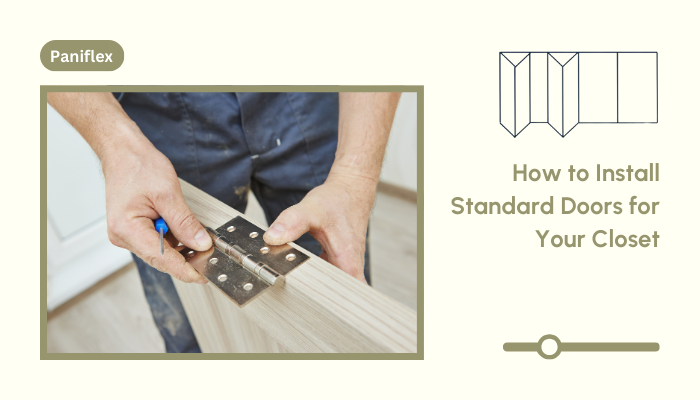As an interior designer or architect, you understand that the devil is in the details. Every space element contributes to its overall aesthetic and functionality; you cannot overlook closet doors. While they seem like a minor component, well-chosen and adequately installed closet doors can elevate a room’s design, improve storage functionality, and even impact the perceived spaciousness of an area.
Installing closet doors is a skill that can set you apart in your field. You can offer comprehensive solutions to your clients, from conceptual design to practical implementation. While Paniflex provides a wide range of custom closet door solutions that can streamline this process, understanding the intricacies of standard door installation is invaluable. This knowledge lets you decide when to opt for custom solutions and when standard options suffice.
Ready to experience the benefits of custom closet doors? Explore our range of Paniflex products now.
So, let’s start by gathering everything you’ll need to tackle this project confidently.
Required Materials and Tools
Before embarking on the installation process, having all the necessary materials and tools is crucial. Preparing thoroughly streamlines the installation and helps you prevent delays and potential mistakes. Here’s a comprehensive list of what you’ll need:
- Hammer
- Chisel
- Drill/Power drill with various bits
- Screwdriver
- Hinges (2 per door, four total)
- Ball Catch (1 per door, two total)
- Dummy doorknobs (1 per door, two total)
- Slab doors (not pre-hung)
- Butt marker for hinges
- Level
- Measuring tape
- Pencil
- Sandpaper
- Wood filler
- Paint and brushes/rollers
Also Read: Choosing the Best Material for Closet Doors
Pro tip: While this guide focuses on standard doors, consider exploring Paniflex’s custom closet door options for unique design opportunities in your projects.
All set? Great, now let’s move on to preparing the door frame for installation!
Initial Preparations
The success of your closet door installation largely depends on the accuracy of your initial preparations. This phase ensures a smooth installation process and a polished final result. Here’s a detailed breakdown of the preparatory steps:
- Assess the door frame:
- Use a level to check if the door frame is square. Place the level on the frame’s top, bottom, and sides.
- If the frame isn’t square, you may need to make adjustments before proceeding.
- Measure the door opening:
- Take multiple measurements of the opening’s height and width. Measure at the top, middle, and bottom for both dimensions.
- Use the smallest measurements as your guide to ensure the doors will fit even if the opening isn’t perfectly uniform.
- Confirm proper door size:
- Compare your measurements to the dimensions of your chosen doors.
- If necessary, trim the doors to fit. Remember to account for clearances: typically 1/8″ at the top and sides and 1/2″ at the bottom for carpet clearance (or 1/4″ for hard flooring).
- Prepare the doors:
- If trimming is needed, use a circular saw with a fine-toothed blade for clean cuts.
- Sand any cut edges smoothly to prepare for painting or finishing.
- Check the flooring:
- Ensure the flooring is level where the doors will swing. Uneven flooring can cause issues with door alignment and operation.
Remember, precise measurements are crucial for a seamless installation. If you’re working on a high-end project where even minor imperfections are unacceptable, consider Paniflex’s custom-sized doors.
Remove Old Doors and Track
This step is crucial for preparing the space for new installation if you’re replacing existing doors. Here’s a detailed guide on how to properly remove old doors and prepare the opening:
- Remove old sliding doors:
- Start by lifting the doors off their tracks. Most sliding doors can be lifted straight up and pulled out at the bottom.
- If dealing with bifold doors, unhook them from the top track and lift them out of the bottom pivots.
- Be cautious; solid wood or heavy materials can make the doors quite heavy.
- Remove the closet track:
- Unscrew and remove the top track. This is usually secured with screws at regular intervals.
- If there’s a bottom track, remove this as well. Some may be glued down, in which case you might need a pry bar to remove it carefully.
- Fill any screw holes left in the frame with wood filler and sand smooth once dry.
- Remove any extra molding inside the door frame:
- Inspect the door frame for decorative molding that might interfere with the new doors.
- Use a pry bar to carefully remove any such molding, taking care not to damage the surrounding wall or frame.
- Prep the top of the door frame:
- Ensure the top of the frame is smooth and level. This is crucial for the proper operation of the new doors.
- Use a level to check for any unevenness. Mark high spots that need to be sanded down.
- Sand down any high spots using medium-grit sandpaper, followed by fine-grit for a smooth finish.
- If there are low spots, fill them with wood filler. Once dry, sand these areas smooth and level with the rest of the frame.
- Clean the entire frame thoroughly to remove any dust or debris.
- Inspect for damage:
- Look for any signs of water damage, rot, or insect infestation in the exposed frame.
- If you find any issues, address these before proceeding with the new installation.
Also Read: Comparing Vinyl and Wood Door Frames: Building and Parts Guide
Inspect for any signs of damage or irregularity that could affect installation.
Once the old doors and tracks are out, it’s time to get those hinges just right.
Mark and Install Hinges
Proper hinge installation is crucial for smooth door operation. This step requires precision and attention to detail to ensure the doors hang correctly and operate smoothly. Here’s an expanded guide on marking and installing hinges:
- Determine hinge placement:
- Standard practice is to place hinges 7″ from the top of the door, 11″ from the bottom, and a third hinge at the midpoint for doors over 7′ tall.
- Two hinges placed at 1/3 and 2/3 of the door height often suffice for shorter doors.
- Mark hinge positions:
- Use a pencil to mark the positions on the door and frame lightly.
- Double-check that these marks align when the door is in its closed position.
- Use a butt marker:
- Place the butt marker against the edge of the door at your marked positions.
- Tap the butt marker lightly with a hammer to create an outline for the hinge.
- Create clearance for the ball catch:
- Remember to leave about 1/8″ clearance at the top of the door for the ball catch.
- You should adjust your top hinge position slightly below the standard 7 inches.
- Chisel out hinge recesses:
- Use a sharp chisel to remove wood within the outlined hinge areas carefully.
- Work slowly and check the depth frequently. The hinge should sit flush with the door surface when recessed.
- Use a utility knife for clean edges:
- Before chiseling, score around the hinge outline with a utility knife.
- This prevents wood from splintering outside the hinge area, ensuring crisp edges.
- Test fit the hinges:
- Place the hinges in the recesses to check for proper fit.
- They should sit flush with the door surface. Adjust as necessary.
- Drill pilot holes:
- Mark and drill pilot holes for the hinge screws. This prevents wood splitting and ensures proper screw placement.
- Attach hinges to the door:
- Screw the hinges into place on the door. Ensure they’re tight, but be careful not to over-tighten, which can strip the wood.
- Repeat for the door frame:
- Follow the same process to mark and create recesses in the door frame.
- Ensure these align perfectly with the door hinges when the door is in the closed position.
Also Read: Expert Guide: Door Hardware Installation for Modern Design Professionals
Pre-hung door options can save time and ensure flawless alignment, especially in high-end projects where precision is paramount.
With the hinges securely in place, let’s turn our attention to the ball catches next.
Install Ball Catches
Ball catches are essential for keeping your closet doors securely closed when not in use. They provide a smooth, satisfying click when the door closes and prevent the doors from swinging open unintentionally. Here’s a detailed guide on installing ball catches:
- Choose the proper ball catch:
- Select a ball catch appropriate for the weight and style of your doors.
- Heavier doors may require more robust catches to hold them securely.
- Mark the position:
- Typically, ball catches are installed at the top of the door, centered on the width.
- Mark the center point on both the top edge of the door and the corresponding point on the door frame with a pencil.
- Prepare for the catch on the door:
- Place the ball mechanism on your mark at the top of the door and trace its outline.
- Chisel out space for the catch:
- Use a sharp chisel to remove wood within the outlined area carefully.
- Work slowly and check the depth frequently. The catch should sit flush with or slightly recessed from the door’s top edge.
- Drill the hole for the ball:
- Use the drill bit of the appropriate size specified in the catch’s instructions.
- Drill carefully, ensuring the hole is straight and at the correct depth.
- Install the catch on the door:
- Place the catch into the chiseled recess and secure it with the provided screws.
- Ensure it’s level and flush with the door’s edge.
- Mark and install the strike plate:
- Close the door and use the installed catch to mark where the strike plate should go on the door frame.
- Chisel out a recess for the strike plate, similar to how you did for the catch on the door.
- Secure the strike plate with screws.
- Test and adjust:
- Close the door to test the catch. It should engage smoothly and hold the door closed.
- If necessary, adjust the position of the strike plate for proper alignment.
- Repeat for the second door:
- If installing double doors, repeat the process for the second door.
- Ensure both catches align correctly when the doors are closed.
Now that the ball catches are sorted, it’s time to attach the doors to their frames.
Attach Doors to Frames
Now that you’ve prepared the doors and frames, it’s time for the crucial step of hanging the doors. This process requires patience and precision to ensure the doors are level, plumb, and operate smoothly. Here’s a detailed guide:
- Prepare the workspace:
- Clear the area around the closet opening for easy movement.
- Have a helper ready, as hanging doors can be more accessible with an extra pair of hands.
- Position the door:
- Lift the door with an assistant’s help and align the hinges with the recesses in the frame.
- Insert a shim under the door to hold it at the correct height while you work.
- Attach the top hinge:
- Start with the top hinge. This will help support the door’s weight while you work on the other hinges.
- Insert the screws but don’t tighten them fully yet. This allows for adjustments.
- Check for alignment:
- Use a level to ensure the door is plumb (vertically straight).
- Check that the gap between the door and frame is consistent.
- Attach remaining hinges:
- Once the top hinge is in place and the door is aligned, attach the middle (if applicable) and bottom hinges.
- Again, don’t fully tighten the screws yet.
- Test the door:
- Gently swing the door open and closed to check its operation.
- Look for any binding or rubbing against the frame.
- Make adjustments:
- If the door isn’t hanging perfectly, now is the time to adjust.
- Loosen or tighten hinge screws as needed to shift the door’s position.
- You may need to add thin shims behind the hinges to achieve perfect alignment.
- Secure the door:
- Once you’re satisfied with the door’s alignment and operation, fully tighten all hinge screws.
- Be careful not to over-tighten, which can strip the wood or distort the hinge.
- Repeat for the second door:
- If installing double doors, repeat the process for the second door.
- Pay extra attention to the alignment between the two doors when closed.
- Final check:
- Open and close the doors several times to ensure smooth operation.
- Check that the ball catches engage properly.
- Verify that the gap between the doors and frame is consistent all around.
Also Read: Simple Methods to Trim the Bottom of a Door
Now that our doors are hung, let’s make those final adjustments and prepare to paint.
Final Adjustments and Painting
The final adjustments and painting stage is where your attention to detail shines, transforming a functional installation into a polished, professional finish. Here’s an expanded guide to ensure your closet doors look and operate flawlessly:
- Fine-tune door alignment:
- With the doors hung, take a final look at their alignment.
- Use a level to check that the doors are perfectly plumb and level.
- Adjust doors using planing or thin shims behind hinges if necessary.
- Ensure the gap between the doors and frame is consistent all around.
- Install a door stop:
- Install a piece of wood across the back of the closet opening to prevent the doors from being pushed inwards.
- It would help if you placed it at a height that allows the doors to close fully but stops them from swinging inwards.
- Prepare for painting:
- Remove the doors from their hinges for easier painting.
- Lightly sand the doors to create a smooth surface for paint adhesion.
- Clean the doors thoroughly to remove all dust and debris.
- Apply a high-quality primer suitable for the door material.
- Apply paint:
- Choose a paint finish appropriate for closet doors. Semi-gloss or satin finishes are often preferred for their durability and ease of cleaning.
- You should apply multiple thin coats of paint rather than one thick coat.
- Allow sufficient drying time between coats, following the paint manufacturer’s recommendations.
- Sand lightly between coats for an ultra-smooth finish.
- Paint absorption considerations:
- Be aware that different parts of the door may absorb paint differently.
- Pay extra attention to the edges and areas where wood grain is more pronounced.
- These areas may require additional coats to achieve an even finish.
- Rehang the doors:
- Carefully rehang the doors once the paint is fully dry (usually 24-48 hours after the final coat).
- Be cautious not to chip the new paint during this process.
- Recheck alignment and make any final adjustments.
- Touch up and finish:
- Once rehung, inspect the doors closely for any paint imperfections.
- Touch up any areas that may have been affected during rehanging.
- Consider applying a clear protective coat for added durability, especially in high-use areas.
- Hardware installation:
- If you removed any hardware for painting, now is the time to reinstall it.
- Securely fasten and adequately align all hardware.
All painted up? Perfect. The last step is to install those stylish dummy doorknobs.
Install Dummy Doorknobs
The final touch in your closet door installation is adding the dummy doorknobs. This step not only completes the doors’ aesthetic but also provides your clients functionality. Here’s a detailed guide to ensure perfect installation:
- Choose appropriate knobs:
- Select dummy doorknobs that complement the style of the doors and the room’s decor.
- Consider factors like finish, size, and shape to ensure they match your design vision.
- Determine knob placement:
- The standard height for doorknobs is typically 36″ from the floor, but you may adjust this based on the door’s design or client preferences.
- For double doors, ensure the knobs will be at the same height on both doors.
- Mark positions accurately:
- Use a measuring tape and level to mark the exact position for each knob.
- Double-check measurements to ensure perfect symmetry, especially on double doors.
- Prepare for installation:
- If the knobs require holes, use a drill with the appropriate bit size to create clean, precise holes.
- For surface-mounted knobs, you may need to create pilot holes to prevent wood splitting.
- Install the knobs:
- Step back and visually inspect the alignment of the knobs.
- Open and close the doors to ensure the knobs don’t interfere with each other or the door frame.
- Make final adjustments:
- If necessary, make minor adjustments to ensure perfect alignment and functionality.
Also Read: How to Install and Replace Closet Doors
Ready to experience the benefits of custom closet doors? Explore our range of Paniflex products now.
Remember, Paniflex offers a variety of stylish hardware options that can perfectly complement its custom doors. This can be an excellent recommendation for clients looking for a cohesive, high-end finish.
And there you have it! Before we wrap up, let’s recap the importance of these steps and how they enhance your designs.
Conclusion
Installing closet doors is a detail-oriented process that can significantly impact a space’s overall aesthetics and functionality. If you master this skill, you can offer comprehensive solutions to your clients, from concept to execution.
When you complete a well-executed project, you will feel immense personal satisfaction. Seeing a pair of perfectly installed closet doors transform a space – enhance its functionality, improve its aesthetics, and potentially even make a room feel more significant—is a rewarding experience. Your clients will appreciate your attention to detail and the professional finish when you execute the installation properly.
Well-installed closet doors can truly elevate a space by improving its aesthetics. They can also serve as a design feature in their own right, complementing the room’s overall style and contributing to a cohesive look.
However, for projects requiring a genuinely unique touch or when dealing with challenging spaces, consider partnering with Paniflex. Their custom closet door solutions can elevate your designs, ensuring each project stands out with precision-fit, stylish doors that perfectly align with your creative vision. From custom sizes to specialized finishes and hardware, Paniflex offers options that can take your closet door designs to the next level.






